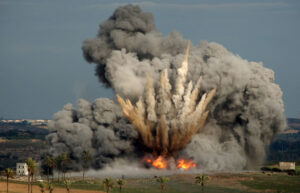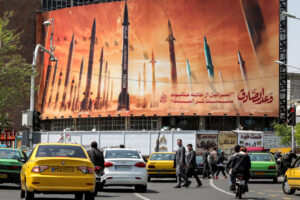Yahya Sinwar, the Hamas mastermind who had the bad luck of crossing paths with a team of 19-year-old Israeli grunts in Rafah on Wednesday morning, was an intractable religious ideologue who saw his life’s purpose in extravagant historical terms. He was someone whose actions corresponded perfectly to his beliefs, and who treated reality as a thin and temporary illusion concealing the God-given triumph to come. Sinwar was, in short, exactly the type of leader that citizens in democratic societies can’t easily comprehend.
Speculating about Sinwar’s motives became an analytical cottage industry after October 7. Observers of the resulting conflagration have been told that Sinwar ordered his invasion and kidnapping spree because he wanted to derail Israeli-Saudi normalisation; put “the Palestinian question” back on the table; bait Benjamin Netanyahu into a regional war; bleed his enemy through an insurgency; fracture Israeli society; or undermine Fatah’s rival claims to leadership of the Palestinian struggle. There’s a category error behind every one of these claims. If Sinwar had been a normal warlord in pursuit of mundane objectives, he could have pursued a less spectacular course that would have greatly improved his chances of remaining the uncontested theocratic dictator of a Mediterranean coastal enclave with two million subjects. More than that, he could have retained a local military-industrial complex, extensive foreign relations, and subsidies from friendly regional governments and the UN. But Sinwar operated beyond the limiting realm of normative politics. He is arguably the first Palestinian leader who ever thought to test the proposition that his people could decisively settle their conflict with the Jews of the Middle East solely through violent means.
A significant body of facts suggests that Sinwar believed he would succeed in destroying the state of Israel on or about October 7, 2023. A few years before the attacks, he co-sponsored a conference at a Gaza City hotel entitled “Promise of the Hereafter: Post-Liberation Palestine” — and in which participants discussed topics such as the enslavement of educated Jews and the mass execution of alleged Arab collaborators in the aftermath of Israel’s imminent violent destruction. “We are sponsoring this conference because it is in line with our assessment that victory is nigh,” read Sinwar’s contribution to the event, which was delivered by a senior colleague in the Hamas political bureau. Sinwar added that “the full liberation of Palestine from the sea to the river” was “the heart of Hamas’s strategic vision”.
He meant this all literally. Documents recovered by the IDF in Gaza showed that Hamas planners anticipated the October 7 attack would reach much further into Israel than it actually did. In recent weeks, IDF units in Lebanon have discovered extensive evidence that Hezbollah’s Radwan forces had pre-positioned weapons and attack teams for an invasion of the Galilee in the months before the October massacre. Sinwar, for his part, had a plausible theory of victory, especially in light of the disarray of Israel’s initial response. If Gaza’s Hamas fighters could make it 30 miles across the desert to their comrades in the West Bank, they could bisect Israel while their Hezbollah allies struck from the north. All the while, he envisaged Arab-Israelis rioting, in a repeat of the country’s 2021 unrest, while Iran lobbed ballistic missiles, and the governments of Egypt, Jordan, and maybe even Turkey joined in too — and the cherished dream of the Muslim conquest of Palestine became dazzlingly real.
Sinwar was a committed ideologue, a man of unwavering and sinister integrity. We are not used to world events being driven by figures whose motives are as pure and uncomplicated as his. Sinwar was reportedly furious at the 2011 deal that freed him after more than 20 years in an Israeli prison: he thought Hamas should have accepted nothing less than the release of all of its prisoners in exchange for the kidnapped IDF soldier Gilad Shalit. While in prison for the alleged strangling of Palestinian informants, Sinwar promised one of his Israeli interrogators that the tables would eventually turn — that one day he would be Sinwar’s prisoner, and that the now-jailed Hamas leader would be grilling him instead.
To put it differently, Sinwar had the quasi-Napoleonic notion of a total social inversion, one he would personally bring into being. Yassir Arafat, who came to deploy a clever interplay of violence and diplomacy, and who turned the Palestine Liberation Organization into a patronage system that was entirely dependent on his leadership, was a corrupt gradualist compared to Sinwar, who represented the total rejection of all pragmatism. Human beings were abstractions to him, the raw material for the new world he would single-handedly forge.
The execution, though, was off. Sinwar turned out to have a poor understanding of both his friends and his enemies. We might never understand why Hezbollah didn’t launch its own ground offensive against Israel on October 7, despite being fully prepared and deployed. Hamas and Hezbollah’s Iranian sponsors clearly knew Sinwar’s war plans, but didn’t fully commit themselves to the fight when the moment came. Israel, meanwhile, proved it could sustain an unprecedentedly long and difficult urban war without losing all international support. Surely Sinwar wasn’t counting on the Israeli-developed Trophy system neutralising Hamas’s anti-tank weaponry, nor on his enemy’s remarkable willingness to send its soldiers and combat engineers into Hamas tunnels. Hamas, meanwhile, fought the IDF with a distinct lack of skill and courage. Its fighters fled from frontal confrontations with the IDF, and failed to protect its infrastructure or halt the Israeli advance through the Strip. All the while, it lost any ability to fire rockets at Israel, and suffered an estimated 19,000 combat deaths since October 7. That’s six times more than all the Palestinian fighters lost in the Second Intifada, and the previous four Gaza Wars combined. A year ago, Hamas had 40,000 combatants, and ran the longest-tenured Sunni Islamist governing project in modern history. Now, though, they’re a glorified protection racket, far more capable of terrorising displaced Gazans than they are of threatening Israelis.
Sinwar’s continued rejection of US-brokered ceasefire agreements, any one of which would have saved his life, only makes sense if he believed his recalcitrance could eventually force Hezbollah and Iran’s other proxies to escalate the war on his behalf. He believed a longer and bloodier conflict favoured him. This was wildly incorrect. A long war actually favoured Israel, which learned how to fight him. Meanwhile, Hezbollah’s limited participation in the conflict dragged on long enough for Jerusalem to lose patience and wipe out the group’s entire high command, along with a reported two-thirds of its missile arsenal.
Sinwar’s loss will still be deeply felt. He killed more Israelis on Israeli territory than anyone else in history, and on October 7 he gave his people an exhilarating taste of what a divinely ordained final victory would look and feel like. Pragmatism may seem lame or even dishonourable in light of that righteous blood orgy, a proof of concept for some future, final cleansing of the land. And he’ll have a potential afterlife as a leading 21st-century theoretician of violent revolution, having pioneered the idea of war as mass protest and an expression of popular rage. The “Tufan Al-Aqsa System” — the Hamasnik phrase for the October 7 attacks — is people power focused towards militant ends, an unstoppable, raging human flood. Sinwar understood that he had the backing of a global and increasingly important institutional Left, an elite constituency in Western countries that rapidly embraced his cause after October 7. “The same type of racism that killed George Floyd is being used by [Israel] against the Palestinians,” Sinwar told Vice News in 2021, anticipating the thesis of Ta-Nehisi Coates’s 2024 book The Message.
But it wasn’t just Leftists who provided cover for Sinwar’s agenda. The surviving senior Hamas leadership is now based in Qatar, a US ally which is home to the largest American military base in the Middle East. Hamas leaders have been feted in Turkey, Russia, and South Africa over the past year. Hamas’s moral legitimacy and international standing arguably grew after October 7. Sinwar showed that raping and butchering Israelis did not automatically make you an enemy of civilisation — not even for the United States, which long opposed any Israeli operation in Rafah, where Sinwar was killed, and spent nearly a year pushing for a ceasefire that would have preserved Hamas’s rule in the Strip. Sinwar’s career may have shown that it is self-destructive in the near term for a Palestinian leader to provoke a full-on war with Israel. But he will have inspired a future generation of extremists to dream big.
Disclaimer
Some of the posts we share are controversial and we do not necessarily agree with them in the whole extend. Sometimes we agree with the content or part of it but we do not agree with the narration or language. Nevertheless we find them somehow interesting, valuable and/or informative or we share them, because we strongly believe in freedom of speech, free press and journalism. We strongly encourage you to have a critical approach to all the content, do your own research and analysis to build your own opinion.
We would be glad to have your feedback.
Source: UnHerd Read the original article here: https://unherd.com/



